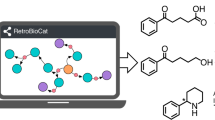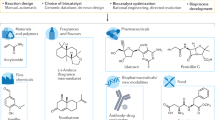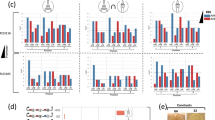Abstract
Recursive pathways are broadly defined as those that catalyze a series of reactions such that the key, bond-forming functional group of the substrate is always regenerated in each cycle, allowing for a new cycle of reactions to begin. Recursive carbon-chain elongation pathways in nature produce fatty acids, polyketides, isoprenoids and α-keto acids (αKAs), which all use modular or iterative approaches for chain elongation. Recently, an artificial pathway for αKA elongation has been built that uses an engineered isopropylmalate synthase to recursively condense acetyl-CoA with αKAs. This synthetic approach expands the possibilities for recursive pathways beyond the modular or iterative synthesis of natural products and serves as a case study for understanding the challenges of building recursive pathways from nonrecursive enzymes. There exists the potential to design synthetic recursive pathways far beyond what nature has evolved.
This is a preview of subscription content, access via your institution
Access options
Subscribe to this journal
Receive 12 print issues and online access
$259.00 per year
only $21.58 per issue
Buy this article
- Purchase on Springer Link
- Instant access to full article PDF
Prices may be subject to local taxes which are calculated during checkout





Similar content being viewed by others
References
Chan, Y.A. & Thomas, M.G. Formation and characterization of acyl carrier protein-linked polyketide synthase extender units. Methods Enzymol. 459, 143–163 (2009).
Withers, S.T. & Keasling, J.D. Biosynthesis and engineering of isoprenoid small molecules. Appl. Microbiol. Biotechnol. 73, 980–990 (2007).
Felnagle, E.A. et al. Nonribosomal peptide synthetases involved in the production of medically relevant natural products. Mol. Pharm. 5, 191–211 (2008).
Gridnev, A.A. & Ittel, S.D. Catalytic chain transfer in free-radical polymerizations. Chem. Rev. 101, 3611–3660 (2001).
Satoh, K. & Kamigaito, M. Stereospecific living radical polymerization: dual control of chain length and tacticity for precision polymer synthesis. Chem. Rev. 109, 5120–5156 (2009).
Lo, P.K. & Sleiman, H.F. Nucleobase-templated polymerization: copying the chain length and polydispersity of living polymers into conjugated polymers. J. Am. Chem. Soc. 131, 4182–4183 (2009).
Grondal, C., Jeanty, M. & Enders, D. Organocatalytic cascade reactions as a new tool in total synthesis. Nat. Chem. 2, 167–178 (2010).
Baran, P.S., Maimone, T.J. & Richter, J.M. Total synthesis of marine natural products without using protecting groups. Nature 446, 404–408 (2007).
Thelen, J.J. & Ohlrogge, J.B. Metabolic engineering of fatty acid biosynthesis in plants. Metab. Eng. 4, 12–21 (2002).
Napier, J.A. & Graham, I.A. Tailoring plant lipid composition: designer oilseeds come of age. Curr. Opin. Plant Biol. 13, 330–337 (2010).
Goh, E.-B., Baidoo, E.E.K., Keasling, J.D. & Beller, H.R. Engineering of bacterial methyl ketone synthesis for biofuels. Appl. Environ. Microbiol. 78, 70–80 (2012).
Steen, E.J. et al. Microbial production of fatty-acid-derived fuels and chemicals from plant biomass. Nature 463, 559–562 (2010).
Dellomonaco, C., Clomburg, J.M., Miller, E.N. & Gonzalez, R. Engineered reversal of the beta-oxidation cycle for the synthesis of fuels and chemicals. Nature 476, 355–359 (2011).
Liu, T., Chiang, Y.-M., Somoza, A.D., Oakley, B.R. & Wang, C.C.C. Engineering of an “unnatural” natural product by swapping polyketide synthase domains in Aspergillus nidulans. J. Am. Chem. Soc. 133, 13314–13316 (2011).
McDaniel, R. et al. Multiple genetic modifications of the erythromycin polyketide synthase to produce a library of novel “unnatural” natural products. Proc. Natl. Acad. Sci. USA 96, 1846–1851 (1999).
Reeves, C.D. et al. Alteration of the substrate specificity of a modular polyketide synthase acyltransferase domain through site-specific mutations. Biochemistry 40, 15464–15470 (2001).
Reeves, C.D. et al. Production of hybrid 16-membered macrolides by expressing combinations of polyketide synthase genes in engineered Streptomyces fradiae hosts. Chem. Biol. 11, 1465–1472 (2004).
Weissman, K.J. Mutasynthesis—uniting chemistry and genetics for drug discovery. Trends Biotechnol. 25, 139–142 (2007).
Mo, S. et al. Biosynthesis of the allylmalonyl-CoA extender unit for the FK506 polyketide synthase proceeds through a dedicated polyketide synthase and facilitates the mutasynthesis of analogues. J. Am. Chem. Soc. 133, 976–985 (2011).
Baerga-Ortiz, A. et al. Directed mutagenesis alters the stereochemistry of catalysis by isolated ketoreductase domains from the erythromycin polyketide synthase. Chem. Biol. 13, 277–285 (2006).
Das, A., Szu, P.H., Fitzgerald, J.T. & Khosla, C. Mechanism and engineering of polyketide chain initiation in fredericamycin biosynthesis. J. Am. Chem. Soc. 132, 8831–8833 (2010).
Werneburg, M. et al. Exploiting enzymatic promiscuity to engineer a focused library of highly selective antifungal and antiproliferative aureothin analogues. J. Am. Chem. Soc. 132, 10407–10413 (2010).
Austin, M.B., Bowman, M.E., Ferrer, J.L., Schroder, J. & Noel, J.P. An aldol switch discovered in stilbene synthases mediates cyclization specificity of type III polyketide synthases. Chem. Biol. 11, 1179–1194 (2004).
Crawford, J.M. & Townsend, C.A. New insights into the formation of fungal aromatic polyketides. Nat. Rev. Microbiol. 8, 879–889 (2010).
Ma, S.M. et al. Redirecting the cyclization steps of fungal polyketide synthase. J. Am. Chem. Soc. 130, 38–39 (2008).
Ro, D.-K. et al. Production of the antimalarial drug precursor artemisinic acid in engineered yeast. Nature 440, 940–943 (2006).
Ajikumar, P.K. et al. Isoprenoid pathway optimization for Taxol precursor overproduction in Escherichia coli. Science 330, 70–74 (2010).
Zhou, Y.J. et al. Modular pathway engineering of diterpenoid synthases and the mevalonic acid pathway for miltiradiene production. J. Am. Chem. Soc. 134, 3234–3241 (2012).
Lopez-Gallego, F., Agger, S.A., Abate-Pella, D., Distefano, M.D. & Schmidt-Dannert, C. Sesquiterpene synthases Cop4 and Cop6 from Coprinus cinereus: catalytic promiscuity and cyclization of farnesyl pyrophosphate geometric isomers. ChemBioChem. 11, 1093–1106 (2010).
Christianson, D.W. Unearthing the roots of the terpenome. Curr. Opin. Chem. Biol. 12, 141–150 (2008).
Thulasiram, H.V., Erickson, H.K. & Poulter, C.D. Chimeras of two isoprenoid synthases catalyze all four coupling reactions in isoprenoid biosynthesis. Science 316, 73–76 (2007).
Yoshikuni, Y., Martin, V.J.J., Ferrin, T.E. & Keasling, J.D. Engineering cotton (+)-[δ]-cadinene synthase to an altered function: germacrene d-4-ol synthase. Chem. Biol. 13, 91–98 (2006).
O'Maille, P.E. et al. Quantitative exploration of the catalytic landscape separating divergent plant sesquiterpene synthases. Nat. Chem. Biol. 4, 617–623 (2008).
Greenhagen, B.T., O'Maille, P.E., Noel, J.P. & Chappell, J. Identifying and manipulating structural determinates linking catalytic specificities in terpene synthases. Proc. Natl. Acad. Sci. USA 103, 9826–9831 (2006).
Zhang, K., Sawaya, M.R., Eisenberg, D.S. & Liao, J.C. Expanding metabolism for biosynthesis of nonnatural alcohols. Proc. Natl. Acad. Sci. USA 105, 20653–20658 (2008).
Atsumi, S., Hanai, T. & Liao, J.C. Non-fermentative pathways for synthesis of branched-chain higher alcohols as biofuels. Nature 451, 86–89 (2008).
Shen, C.R. & Liao, J.C. Metabolic engineering of Escherichia coli for 1-butanol and 1-propanol production via the keto-acid pathways. Metab. Eng. 10, 312–320 (2008).
Marcheschi, R.J. et al. A synthetic recursive “+1” pathway for carbon chain elongation. ACS Chem. Biol. published online, doi: 10.1021/cb200313e (13 January 2012).
Kroumova, A.B. & Wagner, G.J. Different elongation pathways in the biosynthesis of acyl groups of trichome exudate sugar esters from various solanaceous plants. Planta 216, 1013–1021 (2003).
Slocombe, S.P. et al. Transcriptomic and reverse genetic analyses of branched-chain fatty acid and acyl sugar production in Solanum pennellii and Nicotiana benthamiana. Plant Physiol. 148, 1830–1846 (2008).
Field, B., Furniss, C., Wilkinson, A. & Mithen, R. Expression of a Brassica isopropylmalate synthase gene in Arabidopsis perturbs both glucosinolate and amino acid metabolism. Plant Mol. Biol. 60, 717–727 (2006).
Textor, S. et al. Biosynthesis of methionine-derived glucosinolates in Arabidopsis thaliana: recombinant expression and characterization of methylthioalkylmalate synthase, the condensing enzyme of the chain-elongation cycle. Planta 218, 1026–1035 (2004).
Textor, S., de Kraker, J.W., Hause, B., Gershenzon, J. & Tokuhisa, J.G. MAM3 catalyzes the formation of all aliphatic glucosinolate chain lengths in Arabidopsis. Plant Physiol. 144, 60–71 (2007).
Sønderby, I.E., Geu-Flores, F. & Halkier, B.A. Biosynthesis of glucosinolates—gene discovery and beyond. Trends Plant Sci. 15, 283–290 (2010).
Kliebenstein, D.J. et al. Genetic control of natural variation in Arabidopsis glucosinolate accumulation. Plant Physiol. 126, 811–825 (2001).
Halkier, B.A. & Gershenzon, J. Biology and biochemistry of glucosinolates. Annu. Rev. Plant Biol. 57, 303–333 (2006).
de Kraker, J.W. & Gershenzon, J. From amino acid to glucosinolate biosynthesis: protein sequence changes in the evolution of methylthioalkylmalate synthase in Arabidopsis. Plant Cell 23, 38–53 (2011).
Benderoth, M., Pfalz, M. & Kroymann, J. Methylthioalkylmalate synthases: genetics, ecology and evolution. Phytochem. Rev. 8, 255–268 (2009).
Howell, D.M., Harich, K., Xu, H.M. & White, R.H. α-keto acid chain elongation reactions involved in the biosynthesis of coenzyme B (7-mercaptoheptanoyl threonine phosphate) in methanogenic archaea. Biochemistry 37, 10108–10117 (1998).
Drevland, R.M., Jia, Y.H., Palmer, D.R.J. & Graham, D.E. Methanogen homoaconitase catalyzes both hydrolyase reactions in coenzyme B biosynthesis. J. Biol. Chem. 283, 28888–28896 (2008).
Benderoth, M. et al. Positive selection driving diversification in plant secondary metabolism. Proc. Natl. Acad. Sci. USA 103, 9118–9123 (2006).
de Kraker, J.W., Luck, K., Textor, S., Tokuhisa, J.G. & Gershenzon, J. Two Arabidopsis genes (IPMS1 and IPMS2) encode isopropylmalate synthase, the branchpoint step in the biosynthesis of leucine. Plant Physiol. 143, 970–986 (2007).
Koon, N., Squire, C.J. & Baker, E.N. Crystal structure of LeuA from Mycobacterium tuberculosis, a key enzyme in leucine biosynthesis. Proc. Natl. Acad. Sci. USA 101, 8295–8300 (2004).
Pieper, U. et al. MODBASE, a database of annotated comparative protein structure models and associated resources. Nucleic Acids Res. 37, D347–D354 (2009).
Khosla, C. & Harbury, P.B. Modular enzymes. Nature 409, 247–252 (2001).
Pickens, L.B., Tang, Y. & Chooi, Y.H. Metabolic engineering for the production of natural products. Annu. Rev. Chem. Biomol. Eng. 2, 211–236 (2011).
Rausch, C., Hoof, I., Weber, T., Wohlleben, W. & Huson, D. Phylogenetic analysis of condensation domains in NRPS sheds light on their functional evolution. BMC Evol. Biol. 7, 78 (2007).
Moss, S.J., Martin, C.J. & Wilkinson, B. Loss of co-linearity by modular polyketide synthases: a mechanism for the evolution of chemical diversity. Nat. Prod. Rep. 21, 575–593 (2004).
Singh, K. & Bhakuni, V. Cation induced differential effect on structural and functional properties of Mycobacterium tuberculosis α-isopropylmalate synthase. BMC Struct. Biol. 7, 39 (2007).
Villiers, B.R.M. & Hollfelder, F. Mapping the limits of substrate specificity of the adenylation domain of TycA. ChemBioChem. 10, 671–682 (2009).
Tracewell, C.A. & Arnold, F.H. Directed enzyme evolution: climbing fitness peaks one amino acid at a time. Curr. Opin. Chem. Biol. 13, 3–9 (2009).
Austin, M.B. & Noel, J.P. The chalcone synthase superfamily of type III polyketide synthases. Nat. Prod. Rep. 20, 79–110 (2003).
Lu, X., Vora, H. & Khosla, C. Overproduction of free fatty acids in E. coli: implications for biodiesel production. Metab. Eng. 10, 333–339 (2008).
Zha, W., Rubin-Pitel, S.B., Shao, Z.Y. & Zhao, H.M. Improving cellular malonyl-CoA level in Escherichia coli via metabolic engineering. Metab. Eng. 11, 192–198 (2009).
Takamura, Y. & Nomura, G. Changes in the intracellular concentration of acetyl-coa and malonyl-coa in relation to the carbon and energy-metabolism of Escherichia-Coli-K12. J. Gen. Microbiol. 134, 2249–2253 (1988).
Santos, C.N.S., Koffas, M. & Stephanopoulos, G. Optimization of a heterologous pathway for the production of flavonoids from glucose. Metab. Eng. 13, 392–400 (2011).
Lennen, R.M., Braden, D.J., West, R.M., Dumesic, J.A. & Pfleger, B.F. A process for microbial hydrocarbon synthesis: Overproduction of fatty acids in Escherichia coli and catalytic conversion to alkanes. Biotechnol. Bioeng. 106, 193–202 (2010).
Leonard, E., Lim, K.-H., Saw, P.-N. & Koffas, M.A.G. Engineering central metabolic pathways for high-level flavonoid production in Escherichia coli. Appl. Environ. Microbiol. 73, 3877–3886 (2007).
Yang, Y.-T., Bennett, G.N. & San, K.-Y. The effects of feed and intracellular pyruvate levels on the redistribution of metabolic fluxes in Escherichia coli. Metab. Eng. 3, 115–123 (2001).
Hahn, M. & Stachelhaus, T. Harnessing the potential of communication-mediating domains for the biocombinatorial synthesis of nonribosomal peptides. Proc. Natl. Acad. Sci. USA 103, 275–280 (2006).
Hutchinson, C.R. Polyketide and non-ribosomal peptide synthases: Falling together by coming apart. Proc. Natl. Acad. Sci. USA 100, 3010–3012 (2003).
Thattai, M., Burak, Y. & Shraiman, B.I. The origins of specificity in polyketide synthase protein interactions. PLOS Comput. Biol. 3, 1827–1835 (2007).
Tran, L., Tosin, M., Spencer, J.B., Leadlay, P.F. & Weissman, K.J. Covalent linkage mediates communication between ACP and TE domains in modular polyketide synthases. ChemBioChem. 9, 905–915 (2008).
Dueber, J.E. et al. Synthetic protein scaffolds provide modular control over metabolic flux. Nat. Biotechnol. 27, 753–759 (2009).
Bobik, T.A. Polyhedral organelles compartmenting bacterial metabolic processes. Appl. Microbiol. Biotechnol. 70, 517–525 (2006).
Tanaka, S., Sawaya, M.R. & Yeates, T.O. Structure and mechanisms of a protein-based organelle in Escherichia coli. Science 327, 81–84 (2010).
Parsons, J.B. et al. Synthesis of empty bacterial microcompartments, directed organelle protein incorporation, and evidence of filament-associated organelle movement. Mol. Cell 38, 305–315 (2010).
Bonacci, W. et al. Modularity of a carbon-fixing protein organelle. Proc. Natl. Acad. Sci. USA 109, 478–483 (2012).
Fan, C. et al. Short N-terminal sequences package proteins into bacterial microcompartments. Proc. Natl. Acad. Sci. USA 107, 7509–7514 (2010).
Wang, M., Zhou, H., Wirz, M., Tang, Y. & Boddy, C.N. A thioesterase from an iterative fungal polyketide synthase shows macrocyclization and cross coupling activity and may play a role in controlling iterative cycling through product offloading. Biochemistry 48, 6288–6290 (2009).
Wang, K. & Ohnuma, S. Chain-length determination mechanism of isoprenyl diphosphate synthases and implications for molecular evolution. Trends Biochem. Sci. 24, 445–451 (1999).
Nair, N. & Zhao, H. in The Metabolic Pathway Engineering Handbook Ch. 2, 2-1–2-37 (CRC Press, 2009).
Harper, M.A. et al. Phenotype sequencing: identifying the genes that cause a phenotype directly from pooled sequencing of independent mutants. PLoS ONE 6, e16517 (2011).
Siegel, J.B. et al. Computational design of an enzyme catalyst for a stereoselective bimolecular Diels-Alder reaction. Science 329, 309–313 (2010).
Himo, F. C–C bond formation and cleavage in radical enzymes, a theoretical perspective. Biochim. Biophys. Acta 1707, 24–33 (2005).
Dechancie, J. et al. How similar are enzyme active site geometries derived from quantum mechanical theozymes to crystal structures of enzyme-inhibitor complexes? Implications for enzyme design. Protein Sci. 16, 1851–1866 (2007).
Kiss, G., Röthlisberger, D., Baker, D. & Houk, K.N. Evaluation and ranking of enzyme designs. Protein Sci. 19, 1760–1773 (2010).
Zhu, X. & Lai, L. A novel method for enzyme design. J. Comput. Chem. 30, 256–267 (2009).
Röthlisberger, D. et al. Kemp elimination catalysts by computational enzyme design. Nature 453, 190–195 (2008).
Kuhlman, B. et al. Design of a novel globular protein fold with atomic-level accuracy. Science 302, 1364–1368 (2003).
Jiang, L. et al. De novo computational design of retro-aldol enzymes. Science 319, 1387–1391 (2008).
Looger, L.L., Dwyer, M.A., Smith, J.J. & Hellinga, H.W. Computational design of receptor and sensor proteins with novel functions. Nature 423, 185–190 (2003).
Pauling, L. Nature of forces between large molecules of biological interest. Nature 161, 707–709 (1948).
Tantillo, D.J., Jiangang, C. & Houk, K.N. Theozymes and compuzymes: theoretical models for biological catalysis. Curr. Opin. Chem. Biol. 2, 743–750 (1998).
Acevedo, O. & Jorgensen, W.L. Advances in quantum and molecular mechanical (QM/MM) simulations for organic and enzymatic reactions. Acc. Chem. Res. 43, 142–151 (2010).
Author information
Authors and Affiliations
Corresponding author
Ethics declarations
Competing interests
J.C.L. is a cofounder of Easel Biotechnologies, LLC, which licensed related technologies from University of California–Los Angeles.
Rights and permissions
About this article
Cite this article
Felnagle, E., Chaubey, A., Noey, E. et al. Engineering synthetic recursive pathways to generate non-natural small molecules. Nat Chem Biol 8, 518–526 (2012). https://doi.org/10.1038/nchembio.959
Published:
Issue Date:
DOI: https://doi.org/10.1038/nchembio.959
This article is cited by
-
An orthogonal metabolic framework for one-carbon utilization
Nature Metabolism (2021)
-
Genome-scale target identification in Escherichia coli for high-titer production of free fatty acids
Nature Communications (2021)
-
Multidimensional engineering of Saccharomyces cerevisiae for efficient synthesis of medium-chain fatty acids
Nature Catalysis (2020)
-
The 3-ketoacyl-CoA thiolase: an engineered enzyme for carbon chain elongation of chemical compounds
Applied Microbiology and Biotechnology (2020)
-
In vivo biosensors: mechanisms, development, and applications
Journal of Industrial Microbiology and Biotechnology (2018)



